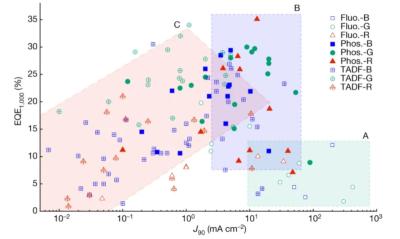Researchers from the University of St. Andrews in the UK, led by Professor Ifor Samuel and Professor Eli Zysman-Colman, identified the key processes controlling the efficiency of TADF OLED emitters under high brightness. This could assist material develops on their quest to design materials that maintain high efficiency at high brightness.
The researchers explain that OLEDs have lower efficiency at higher brightness, and in many TADF materials, the efficiency roll-off is severe, so that the high efficiencies achieved at very low brightness are not maintained at higher brightnesses needed for displays or lighting applications. For the first time, the researcher identified the key processes controlling the triplet population, and propose a figure of merit for efficiency roll-off.
The new figure of merit provides a target for materials development - materials with higher figure of merit should have smaller efficiency roll-off, and hence the figure of merit can guide materials development to enable high efficiency at high brightness, thereby addressing a current limitation of many TADF materials, and so making them more suitable for application in displays and lighting. The researchers hope that this new insights will help company develop new TADF materials.


